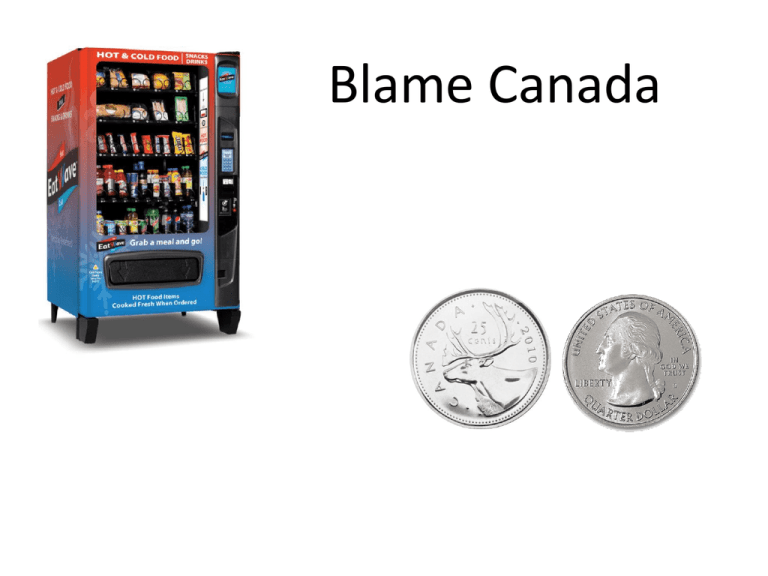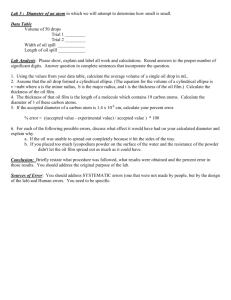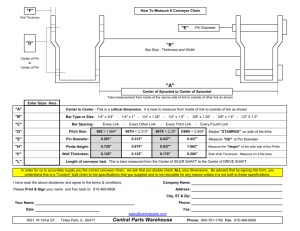Searching_over_features
advertisement

Blame Canada
What features can we cheaply measure from coins?
1.
2.
3.
4.
5.
Diameter
Thickness
Weight
Electrical Resistance
?
Probably not
color or
other optical
features.
The Ideal Case
In the best case, we would find a single feature that would strongly
separate the coins. Diameter is clearly such a feature for the simpler case
of pennies vs. quarters.
Nominally 19.05 mm
Nominally 24.26 mm
Decision
threshold
20mm
25mm
Usage
Once we learn the threshold, we no longer need to keep the data.
When an unknown coin comes in, we measure the feature of interest, and see
which side of the decision threshold it lands on.
IF diameter(unknown_coin) < 22
coin_type = ‘penny’
ELSE
coin_type = ‘quarter’
END
?
Decision threshold
20mm
25mm
Let us revisit the original problem of classifying
Canadian vs. American Quarters
Which of our features (if any) are useful?
1.
2.
3.
4.
Diameter
Thickness
Weight
Electrical Resistance
I measured these features for 50
Canadian and 50 American quarters….
Diameter
Here I have 99% blue on the
right side, but the left side is
about 50/50 green/blue.
1
Thickness
2
Here I have all green on the left
side, but the right side is about
50/50 green/blue.
3
Weight
The weight feature seem very promising.
It is not perfect, but the left side is about 92%
blue, and the right side about 92% green
4
The electrical resistance feature seems promising.
Again, it is not perfect, but the left side is about
89% blue, and the right side about 89% green.
Electrical Resistance
Diameter
We can try all possible pairs of
features.
Thickness
1
1,2
2
{Diameter, Thickness}
{Diameter, Weight}
{Diameter, Electrical Resistance}
{Thickness, Weight}
{Thickness, Electrical Resistance}
{Weight, Electrical Resistance}
This combination does not work
very well.
Diameter
1
3
1,3
Weight
• For brevity, some combinations are omitted
• Let us jump to the last combination…
3
4
3,4
Weight
Electrical Resistance
5
Diameter
0
-5
-10
5
5
0
0
-5
-5
1,2
1,2,3
1
2
1,3
2,3
-10
3
We can also try all possible triples of features.
{Diameter, Thickness, Weight}
{Diameter, Thickness, Electrical Resistance}
etc
This combination does not work that well.
Diameter
Thickness
1,2
1
2
3
4
1,3
2,3
1,4
2,4
3,4
Weight
1,2,3
1,2,4
1,3,4
2,3,4
1,2,3,4
Electrical Resistance
Given a set of N features, there are 2N -1 feature subsets we can test.
In this case, we can test all of them (exhaustive search), but in general, this is not possible.
• 10 features = 1,023
• 20 features = 1,048,576
• 100 features = 1,267,650,600,228,229,401,496,703,205,376
We typically resort to greedy search.
Greedy Forward Section
Initial state: Empty Set: No features
Operators: Add a single feature.
Evaluation Function: K-fold cross validation.
1,2
1,2,3
1
2
3
4
1,3
2,3
1,4
2,4
1,2,4
1,3,4
1,2,3,4
3,4
2,3,4
The Default Rate
How accurate can we be if we use no features?
The answer is called the Default Rate, the size of the most common class, over the size of
the full dataset.
size (most common class )
Default Rate
size (dataset )
No features
Examples:
I want to predict the sex of some pregnant friends babies.
The most common class is ‘boy’, so I will always say ‘boy’.
101
50.024%
101 100
I do just a tiny bit better than random guessing.
I want to predict the sex of the nurse that will give me a
flu shot next week.
The most common class is ‘female’, so I will say ‘female’.
266634
85.29%
266634 45971
Greedy Forward Section
Initial state: Empty Set: No features
Operators: Add a feature.
Evaluation Function: K-fold cross validation.
1
2
3
4
100
80
1,2
1,3
2,3
1,4
2,4
3,4
60
40
1,2,3
1,2,4
1,3,4
2,3,4
20
0
1,2,3,4
{}
Greedy Forward Section
Initial state: Empty Set: No features
Operators: Add a feature.
Evaluation Function: K-fold cross validation.
1
2
3
4
100
80
1,2
1,3
2,3
1,4
2,4
3,4
60
40
1,2,3
1,2,4
1,3,4
2,3,4
20
0
1,2,3,4
{}
{3}
Greedy Forward Section
Initial state: Empty Set: No features
Operators: Add a feature.
Evaluation Function: K-fold cross validation.
1
2
3
4
100
80
1,2
1,3
2,3
1,4
2,4
3,4
60
40
1,2,3
1,2,4
1,3,4
2,3,4
20
0
1,2,3,4
{}
{3}
{3,4}
Greedy Forward Section
Initial state: Empty Set: No features
Operators: Add a feature.
Evaluation Function: K-fold cross validation.
1
2
3
4
100
80
1,2
1,3
2,3
1,4
2,4
3,4
60
40
1,2,3
1,2,4
1,3,4
2,3,4
20
0
1,2,3,4
{}
{3}
{3,4}
{1,3,4}
Sometimes, instead of (or in addition to)
searching for features, we can make new
features out of combinations of old features
in some way.
Recall this “pigeon problem”. …
We could not get good results with a linear
classifier.
Suppose we created a new feature…
Left Bar
Feature Generation I
10
9
8
7
6
5
4
3
2
1
1 2 3 4 5 6 7 8 9 10
Right Bar
Feature Generation II
Suppose we created a new feature, called Fnew
Now the problem is trivial to solve with a linear
classifier.
Left Bar
Fnew = |(Right_Bar – Left_Bar)|
10
9
8
7
6
5
4
3
2
1
1 2 3 4 5 6 7 8 9 10
Right Bar
0
1 2 3 4 5 6 7 8 9 10
Fnew
Feature Generation III
We actually do feature generation all the time.
Consider the problem of classifying underweight,
healthy, obese.
It is a two dimensional problem, that we can
approximately solve with linear classifiers.
But we can generate a feature call BMI, Body-Mass
Index.
BMI = height/ weight2
This converts the problem into a 1D problem
18.5
24.9
BMI






